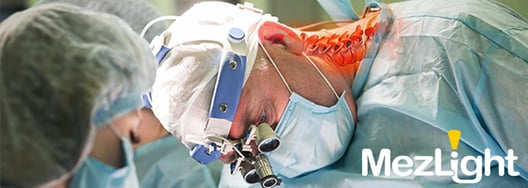
It’s no secret that surgeons often work through and live with pain. Performing surgery is a physically demanding activity that can damage a surgeon’s musculoskeletal health and negatively impact many aspects of their life both in and out of the OR. Furthermore, surgeons themselves aren’t the only ones impacted when they’re dealing with work-related pain and discomfort. A Vanderbilt University study examined the ripple effect that occurs when a surgeon experiences operating room-related musculoskeletal injuries. The study found that the impact of these injuries extends to patients, providers and institutions – all in different ways.
Negative impact on positive outcomes
Every procedure in every OR has a common goal – a positive patient outcome. In order for this to happen there are many elements to consider, from creating a sterile environment, to having the right instruments available, to putting the right surgical team in place. Not surprisingly a crucial element of a successful operation is to have a surgeon who is performing at the top of her or his game. The Vanderbilt study found that that surgical care could be impacted by the pain that surgeons endure while performing surgery.
53% of injured surgeons reported that the pain they were working through had a minimal or moderate effect on their performance in the operating room.
In addition to being distracted by pain in the OR, surgeons often require time off to recover from their injuries. Just over half of the surgeons polled said their pain persisted for a month or longer. This can lead to a decrease in the number of operations they can perform thus increasing the wait time for patients seeking treatment.
Institutions feel the pain, too.
The surgical department’s success at hospitals and other institutions is partly determined by the productivity of their surgeons. When their staff isn’t functioning at its highest level, surgical providers can feel it on many levels:
- Significant lost revenue due to fewer operations performed. On average, surgeons generate $2.1 million in net revenue a year. So, if a surgeon takes off just two weeks to recover from an injury, this equates to more than $80,000 in lost revenue.
- Workplace wellbeing. Keeping surgeons and surgical staff healthy is not only the right thing to do it clearly makes good business sense as well. When surgeons are dealing with their own pain and injury, morale at an institution can take a hit. Workplace wellness plays a role in how successful a hospital is in recruiting and retaining key surgical talent.
While the fact that surgeons can do damage to their own health by performing surgery is a problem, the severity of this issue is uncertain. It seems as though surgeons are often reluctant to share this information with their employers. In fact the Vanderbilt study found that only 50% of surgeons receive treatment for their musculoskeletal injuries (mostly neck, back and hands) and that only 20% of the injuries were reported to the institutions for which these surgeons work.
How did we get here?
In order to help address the epidemic of physicians who deal with pain, it’s important to acknowledge its prevalence and seek to more fully understand the causes. If the rate at which these injuries are reported is woefully low it will remain a challenge to find potential solutions. As mentioned in our previous blog, the injuries and their lingering effects can be attributed to both the act of performing surgery, and a lack of knowledge.
Surgery is a marathon, not a sprint. Physicians spend hours hovering over their patients, often times locking their body into ergonomically compromising positions while bearing the load of a headlight and loupes and staying mindful of keeping a sterile environment. It’s a scenario that is both necessary while operating and very taxing on the surgeon’s body. To address the pain, many end up requiring significant recovery time, undergoing surgical procedures themselves, reducing their caseload, or even retiring early.
While the physicality of surgery may never go away, the lack of education and knowledge about how to prevent and address musculoskeletal occupational injuries might be easier to address. The responses of the surgeons polled for the study made it clear that there is plenty of room for improvement in keeping them informed about how to avoid, address and report injuries.
There’s hope.
Some of the fixes to the pain physicians experience seem obvious and were even called out by surgeons themselves. When asked about their thoughts about how to create a healthier environment, they had some strong opinions:
- More education and training, during medical school, residency and ongoing practice.
- Ergonomically designed surgical equipment and instruments.
- A wholistic commitment to ergonomically supportive posture, surgical techniques and workflow in the OR.
- An increased understanding of how to identify and repot musculoskeletal injuries incurred while performing surgery.
- Adjustments to protocol, such as limiting on-call hours and more assistance in lifting patients.
As for the lack of awareness of ergonomically friendly techniques and ways to report injuries, no single person or organization is at fault. Schools and hospitals need to do a better job of keeping surgeons in the know and the surgeons need to be more proactive about ways to protect themselves from injuries related to poor ergonomics in the OR, and also how to best address these types of injuries when they do occur.
Another measure that surgeons and institutions can take is to adopt the use of instruments and equipment that improve the ergonomic experience in the OR. This is an easy way to address the pain that physicians experience. One example is by replacing the cumbersome but necessary surgeon’s headlamp with a device like the MezLight.
MezLight was created by transplant surgeon Dr. Josh Mezrich after years of working through neck and back pain and seeing his wife – a vascular surgeon – doing the same thing. The MezLight takes the light off of a surgeon’s head, giving them the freedom to move their head and torso to relieve musculoskeletal stress without compromising the illumination of the surgical site.
By embracing the freedom and control that a MezLight offers, institutions and surgeons are taking a step towards addressing the ergonomic challenges impacting surgical procedures and surgeon wellness. To learn more about how MezLight can positively impact surgeons, institutions and patients, click here to start the conversation.


